towing TOYOTA TACOMA 2012 Owners Manual (in English)
[x] Cancel search | Manufacturer: TOYOTA, Model Year: 2012, Model line: TACOMA, Model: TOYOTA TACOMA 2012Pages: 628, PDF Size: 12.11 MB
Page 3 of 628

1
2
3
4
5
6
7
3
2-4. Using other driving systemsCruise control ...................... 174
Rear view monitor system (vehicles with auto
anti-glare inside rear
view mirror) ....................... 178
Four-wheel drive system ..... 186
Active traction control system .............................. 190
AUTO LSD system.............. 192
Rear differential lock system .............................. 194
Downhill Assist Control system .............................. 197
Clutch start cancel switch ... 199
Driving assist systems ........ 200
2-5. Driving information Off-road precautions (4WD models and
PreRunner) ....................... 207
Cargo and luggage ............. 212
Vehicle load limits ............... 217
Winter driving tips ............... 219
Trailer towing ...................... 223
Dinghy towing ..................... 244 3-1. Using the air conditioning
system and defogger
Air conditioning system ...... 248
3-2. Using the audio system Audio system types ............ 255
Using the radio ................... 260
Using the CD player ........... 267
Playing MP3 and WMA discs ................................. 273
Operating an iPod .............. 280
Operating a USB memory ............................ 288
Optimal use of the audio system .............................. 295
Operating the sub woofer (on some Access Cab
models) ............................ 300
Using the AUX port............. 301
Using the steering wheel audio switches.................. 303
Detachable pole antenna ... 306
3-3. Using the Bluetooth
® audio
system
Bluetooth
® audio system .... 309
Using the Bluetooth®
audio system .................... 312
Operating a Bluetooth
®
enabled portable player.... 318
Setting up a Bluetooth
®
enabled portable player.... 320
Bluetooth
® audio system
setup ................................ 325
3Interior and exterior
features
Page 131 of 628
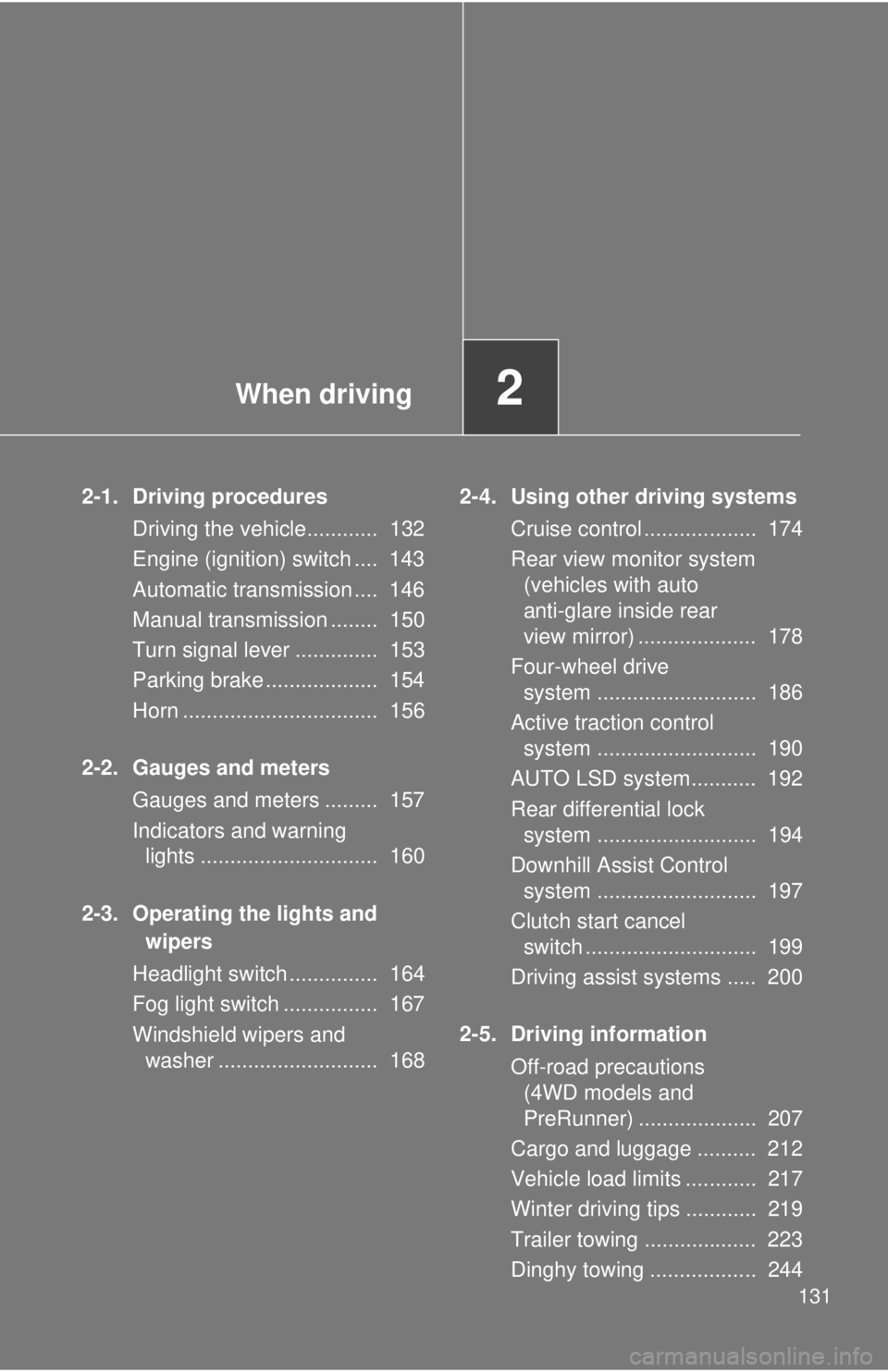
When driving2
131
2-1. Driving proceduresDriving the vehicle............ 132
Engine (ignition) switch .... 143
Automatic transmission .... 146
Manual transmission ........ 150
Turn signal lever .............. 153
Parking brake ................... 154
Horn ................................. 156
2-2. Gauges and meters Gauges and meters ......... 157
Indicators and warning lights .............................. 160
2-3. Operating the lights and wipers
Headlight switch ............... 164
Fog light switch ................ 167
Windshield wipers and washer ........................... 168 2-4. Using other driving systems
Cruise control ................... 174
Rear view monitor system (vehicles with auto
anti-glare inside rear
view mirror) .................... 178
Four-wheel drive system ........................... 186
Active traction control system ........................... 190
AUTO LSD system........... 192
Rear differential lock system ........................... 194
Downhill Assist Control system ........................... 197
Clutch start cancel switch ............................. 199
Driving assist systems ..... 200
2-5. Driving information Off-road precautions (4WD models and
PreRunner) .................... 207
Cargo and luggage .......... 212
Vehicle load limits ............ 217
Winter driving tips ............ 219
Trailer towing ................... 223
Dinghy towing .................. 244
Page 177 of 628
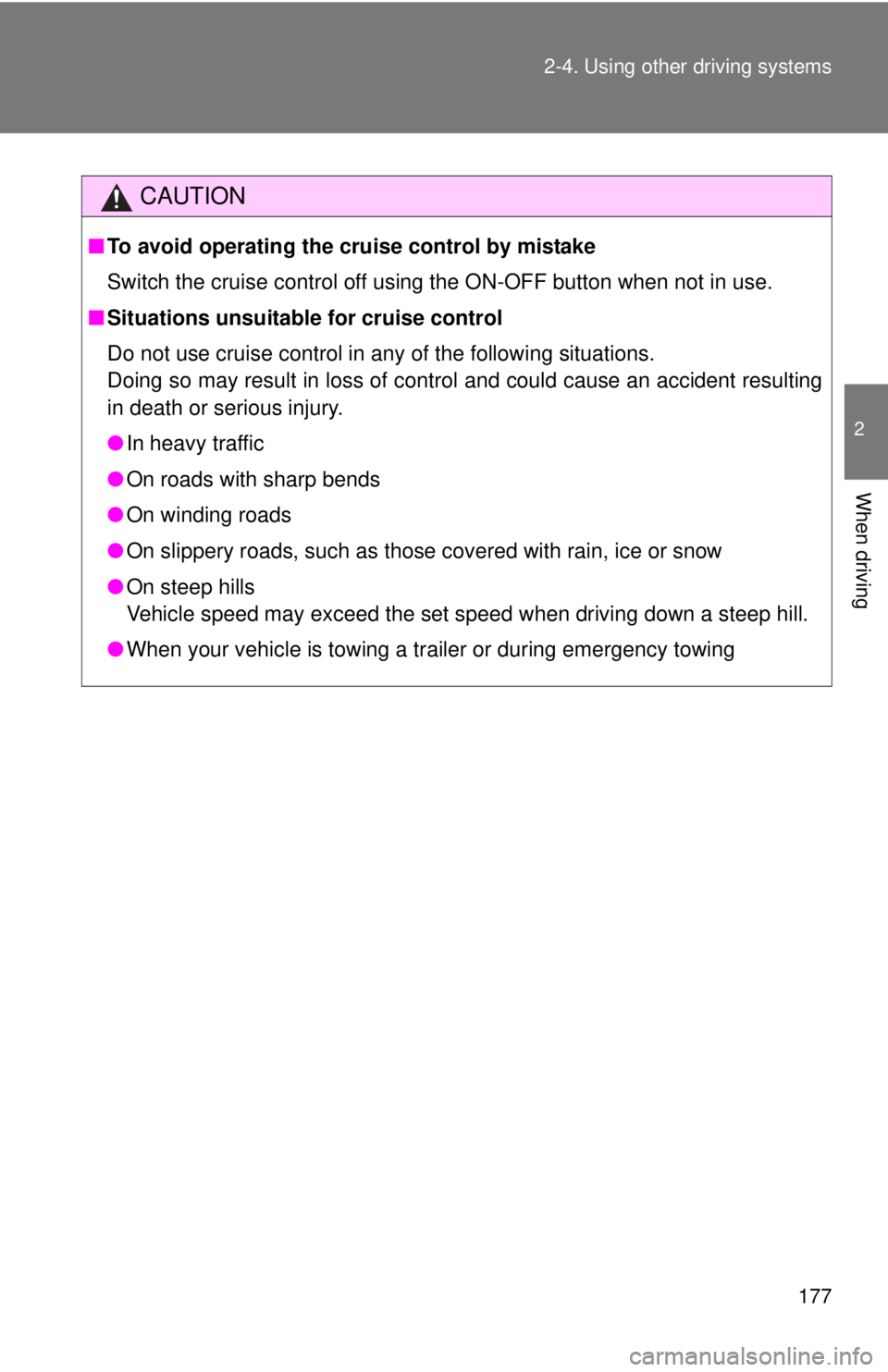
177
2-4. Using other
driving systems
2
When driving
CAUTION
■To avoid operating the cruise control by mistake
Switch the cruise control off using the ON-OFF button when not in use.
■ Situations unsuitable for cruise control
Do not use cruise control in any of the following situations.
Doing so may result in loss of control and could cause an accident resulting
in death or serious injury.
●In heavy traffic
● On roads with sharp bends
● On winding roads
● On slippery roads, such as those covered with rain, ice or snow
● On steep hills
Vehicle speed may exceed the set speed when driving down a steep hill.
● When your vehicle is towing a trailer or during emergency towing
Page 200 of 628
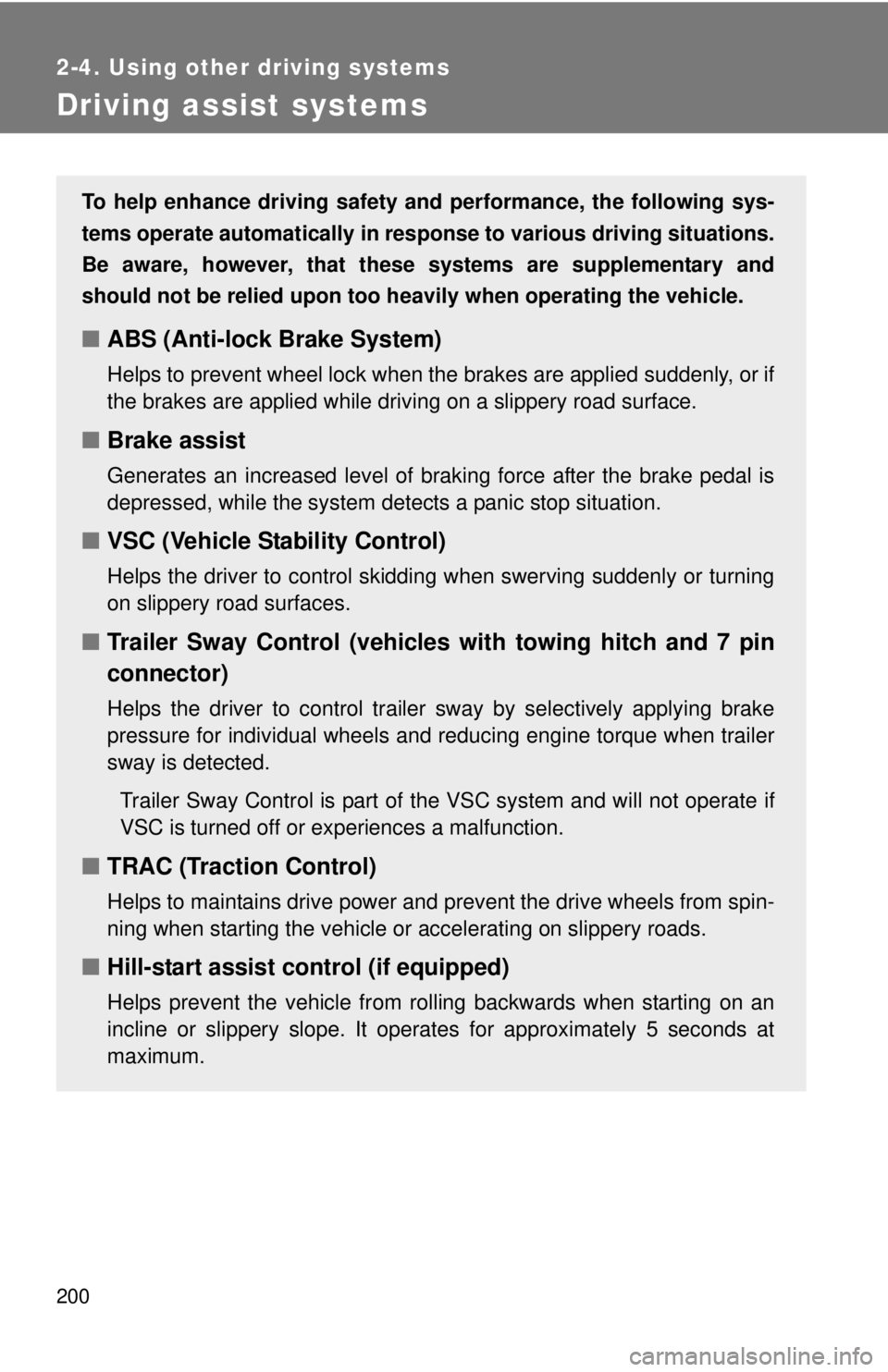
200
2-4. Using other driving systems
Driving assist systems
To help enhance driving safety and performance, the following sys-
tems operate automatically in res ponse to various driving situations.
Be aware, however, that these systems are supplementary and
should not be relied upon too h eavily when operating the vehicle.
■ABS (Anti-lock Brake System)
Helps to prevent wheel lock when the brakes are applied suddenly, or if
the brakes are applied while driving on a slippery road surface.
■Brake assist
Generates an increased level of braking force after the brake pedal is
depressed, while the system detects a panic stop situation.
■VSC (Vehicle Stability Control)
Helps the driver to control skidding when swerving suddenly or turning
on slippery road surfaces.
■Trailer Sway Control (vehicl es with towing hitch and 7 pin
connector)
Helps the driver to control trailer sway by selectively applying brake
pressure for individual wheels and reducing engine torque when trailer
sway is detected.
Trailer Sway Control is part of the VSC system and will not operate if
VSC is turned off or experiences a malfunction.
■ TRAC (Traction Control)
Helps to maintains drive power and prevent the drive wheels from spin-
ning when starting the vehicle or accelerating on slippery roads.
■Hill-start assist control (if equipped)
Helps prevent the vehicle from rolling backwards when starting on an
incline or slippery slope. It operates for approximately 5 seconds at
maximum.
Page 214 of 628
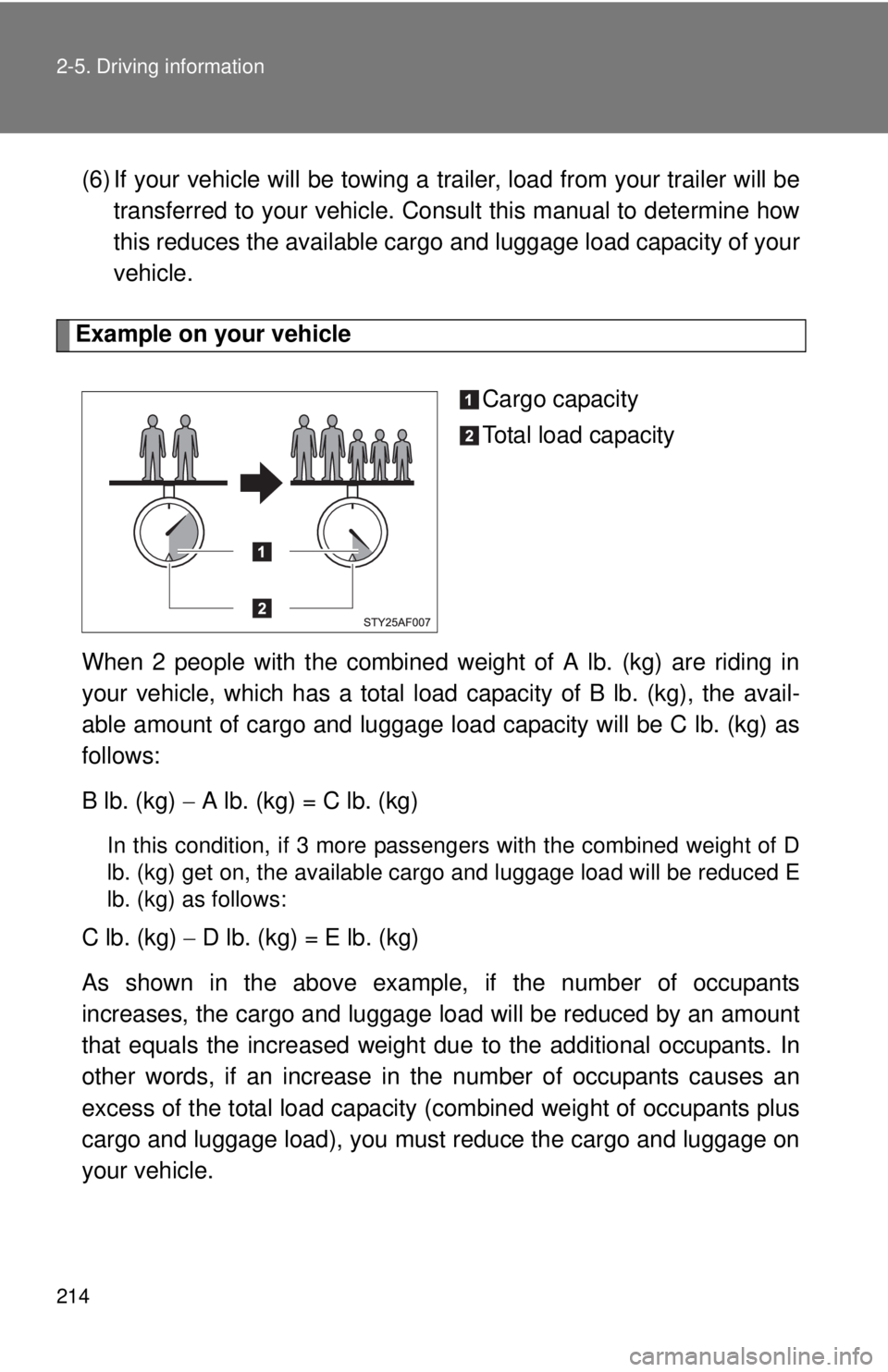
214 2-5. Driving information
(6) If your vehicle will be towing a trailer, load from your trailer will be
transferred to your vehicle. Consult this manual to determine how
this reduces the available cargo and luggage load capacity of your
vehicle.
Example on your vehicle
Cargo capacity
Total load capacity
When 2 people with the combined weight of A lb. (kg) are riding in
your vehicle, which has a total load capacity of B lb. (kg), the avail-
able amount of cargo and luggage load capacity will be C lb. (kg) as
follows:
B lb. (kg) A lb. (kg) = C lb. (kg)
In this condition, if 3 more passengers with the combined weight of D
lb. (kg) get on, the available carg o and luggage load will be reduced E
lb. (kg) as follows:
C lb. (kg) D lb. (kg) = E lb. (kg)
As shown in the above example, if the number of occupants
increases, the cargo and luggage load will be reduced by an amount
that equals the increased weight du e to the additional occupants. In
other words, if an increase in the number of occupants causes an
excess of the total load capacity (combined weight of occupants plus
cargo and luggage load), you must reduce the cargo and luggage on
your vehicle.
Page 223 of 628
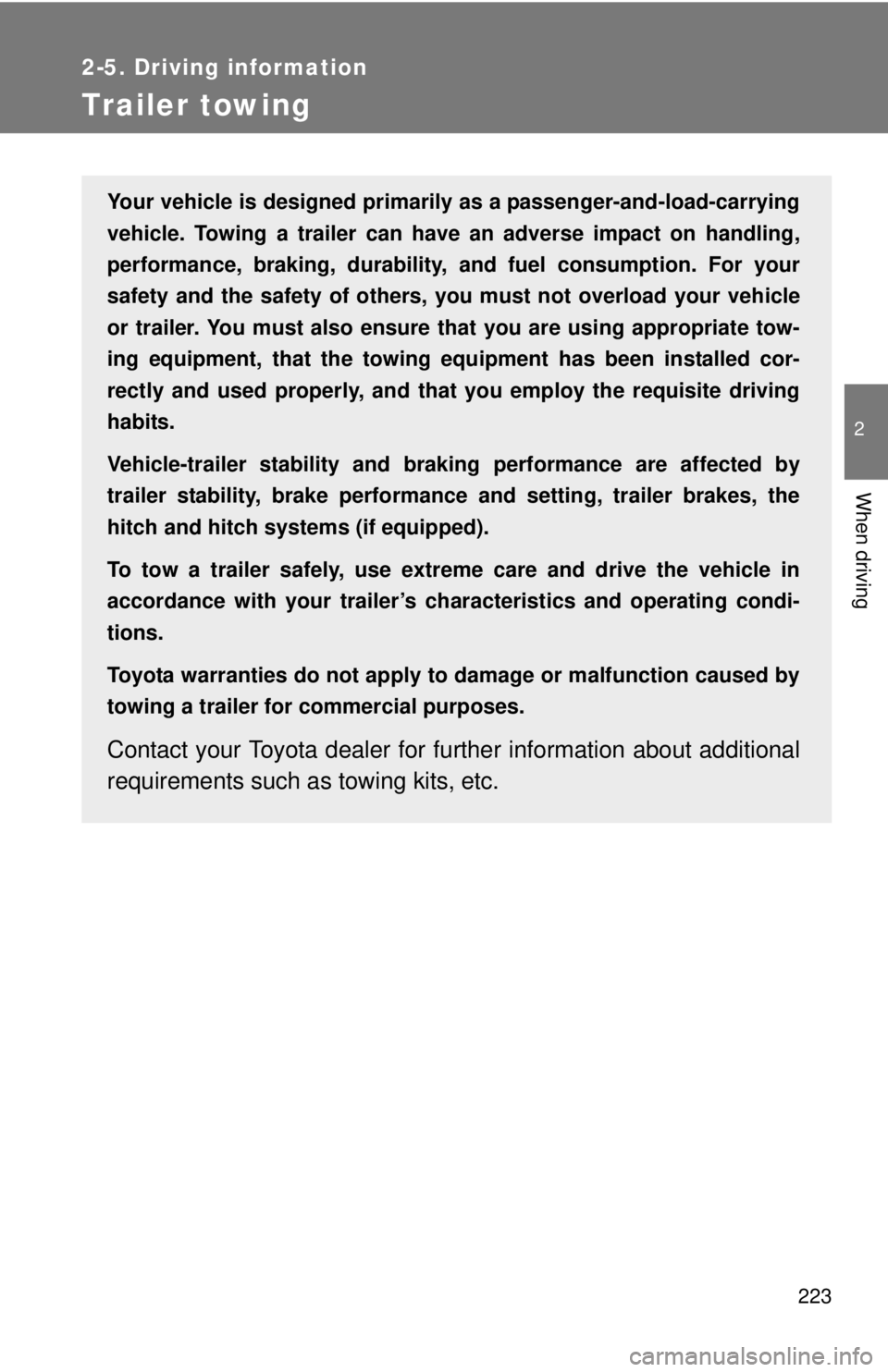
223
2-5. Driving information
2
When driving
Trailer towing
Your vehicle is designed primarily as a passenger-and-load-carrying
vehicle. Towing a trailer can have an adverse impact on handling,
performance, braking, durability, and fuel consumption. For your
safety and the safety of others, yo u must not overload your vehicle
or trailer. You must also ensure that you are using appropriate tow-
ing equipment, that the towing eq uipment has been installed cor-
rectly and used properly, and that you employ the requisite driving
habits.
Vehicle-trailer stability and braki ng performance are affected by
trailer stability, brake performance and setting, trailer brakes, the
hitch and hitch systems (if equipped).
To tow a trailer safely, use extreme care and drive the vehicle in
accordance with your trailer’s characteristics and operating condi-
tions.
Toyota warranties do not apply to damage or malfunction caused by
towing a trailer for commercial purposes.
Contact your Toyota dealer for fu rther information about additional
requirements such as towing kits, etc.
Page 224 of 628
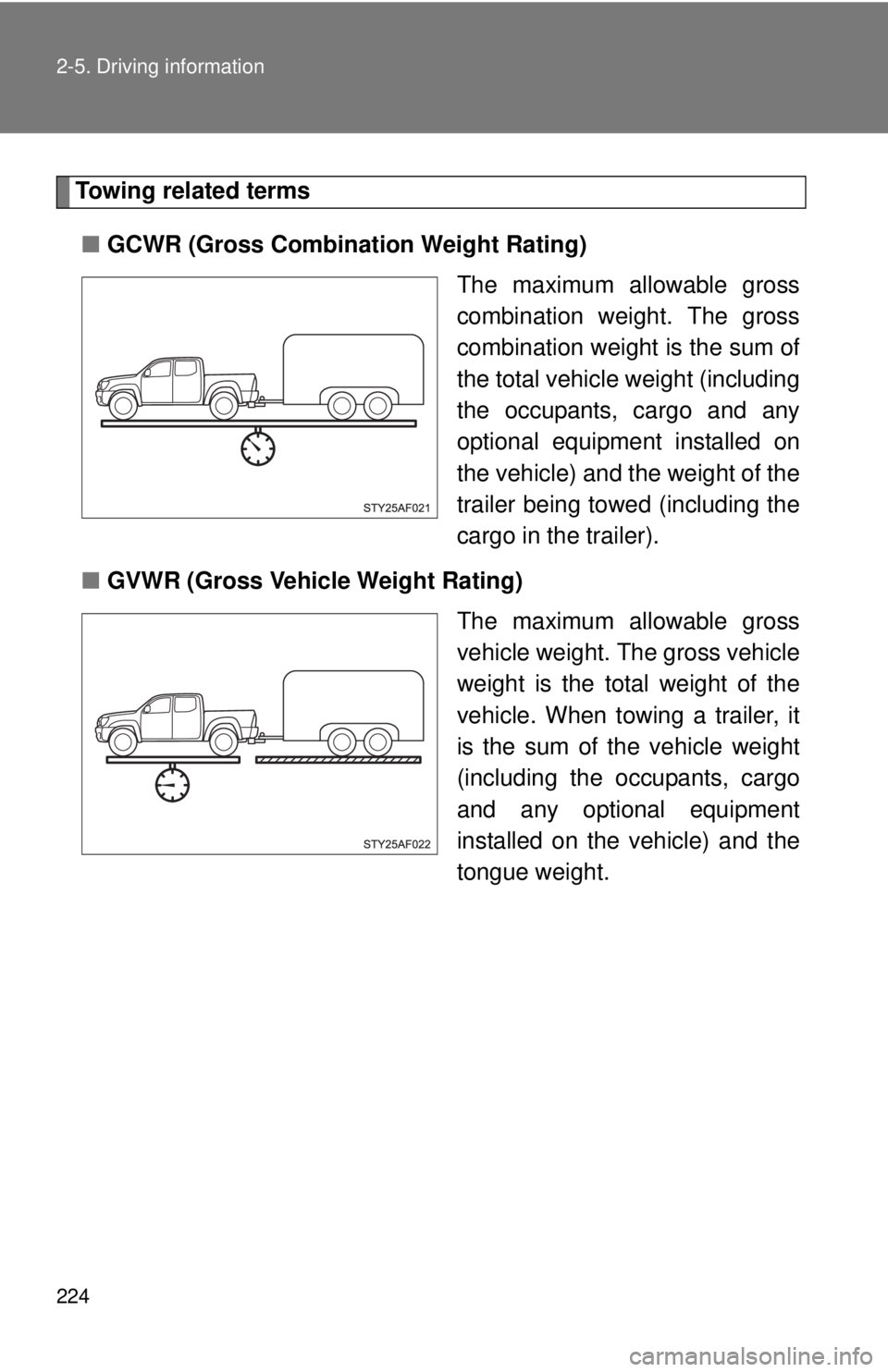
224 2-5. Driving information
Towing related terms■ GCWR (Gross Combination Weight Rating)
The maximum allowable gross
combination weight. The gross
combination weight is the sum of
the total vehicle weight (including
the occupants, cargo and any
optional equipment installed on
the vehicle) and the weight of the
trailer being towed (including the
cargo in the trailer).
■ GVWR (Gross Vehi cle Weight Rating)
The maximum allowable gross
vehicle weight. The gross vehicle
weight is the total weight of the
vehicle. When towing a trailer, it
is the sum of the vehicle weight
(including the occupants, cargo
and any optional equipment
installed on the vehicle) and the
tongue weight.
Page 225 of 628
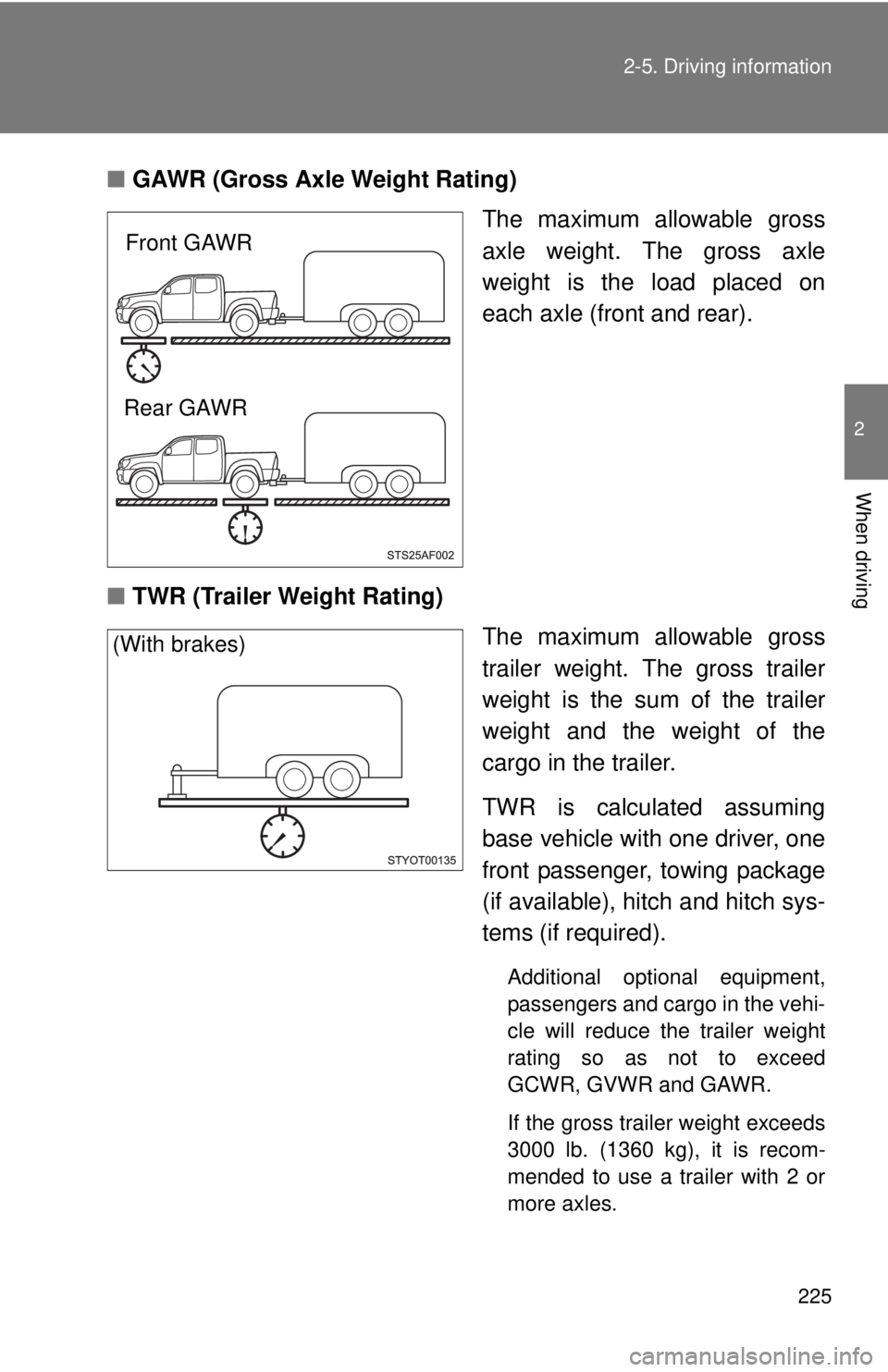
225
2-5. Driving information
2
When driving
■
GAWR (Gross Axle Weight Rating)
The maximum allowable gross
axle weight. The gross axle
weight is the load placed on
each axle (front and rear).
■ TWR (Trailer Weight Rating)
The maximum allowable gross
trailer weight. The gross trailer
weight is the sum of the trailer
weight and the weight of the
cargo in the trailer.
TWR is calculated assuming
base vehicle with one driver, one
front passenger, towing package
(if available), hitch and hitch sys-
tems (if required).
Additional optional equipment,
passengers and cargo in the vehi-
cle will reduce the trailer weight
rating so as not to exceed
GCWR, GVWR and GAWR.
If the gross trailer weight exceeds
3000 lb. (1360 kg), it is recom-
mended to use a trailer with 2 or
more axles.
Front GAWR
Rear GAWR
(With brakes)
Page 228 of 628
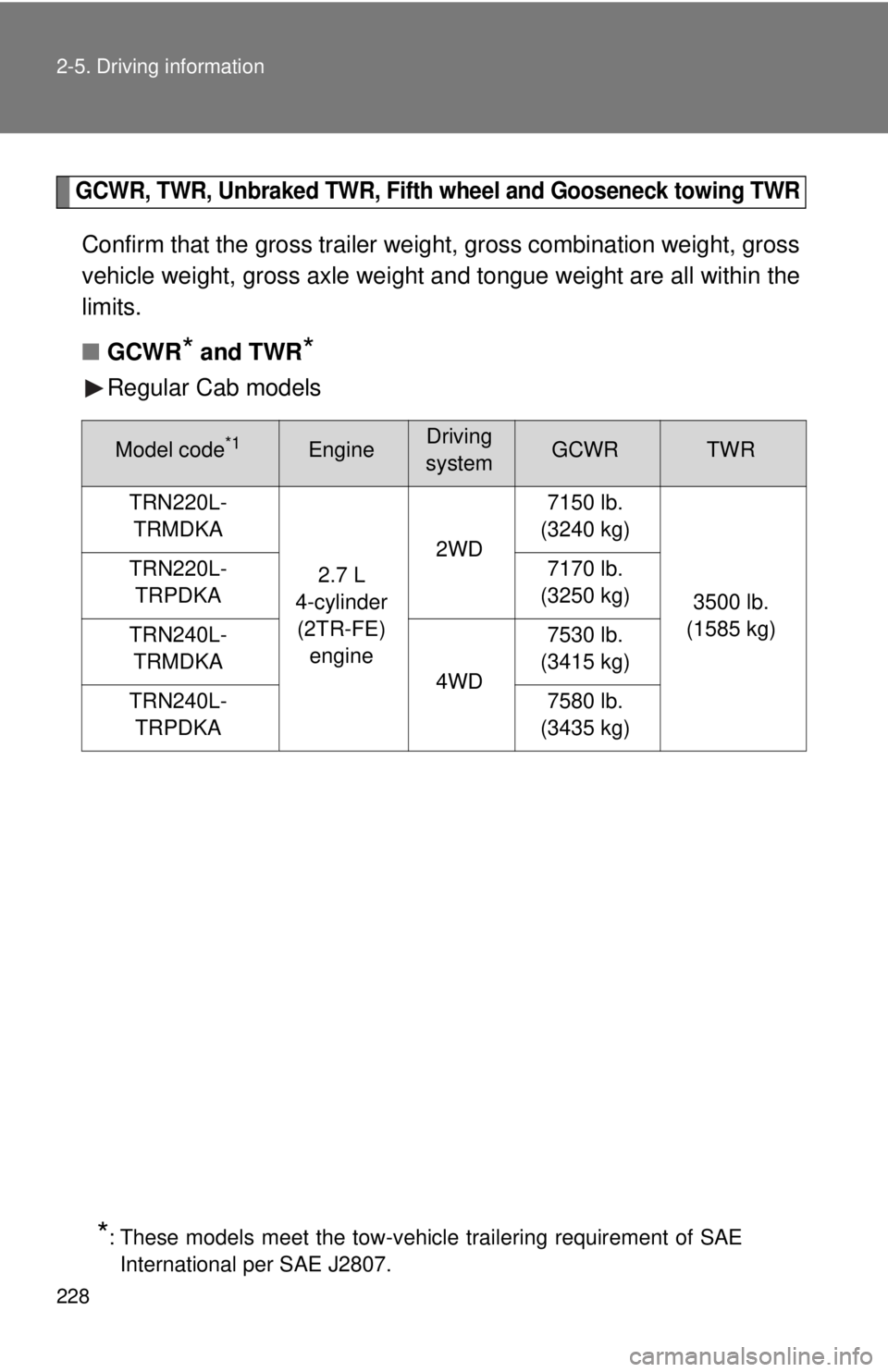
228 2-5. Driving information
GCWR, TWR, Unbraked TWR, Fifth wheel and Gooseneck towing TWR
Confirm that the gross trailer weight, gross combination weight, gross
vehicle weight, gross axle weight and tongue weight are all within the
limits.
■GCWR
* and TWR*
Regular Cab models
*: These models meet the tow-vehicle trailering requirement of SAE
International per SAE J2807.
Model code*1EngineDriving
systemGCWRTWR
TRN220L- TRMDKA
2.7 L
4-cylinder (2TR-FE) engine 2WD
7150 lb.
(3240 kg)
3500 lb.
(1585 kg)
TRN220L-
TRPDKA 7170 lb.
(3250 kg)
TRN240L- TRMDKA 4WD7530 lb.
(3415 kg)
TRN240L- TRPDKA 7580 lb.
(3435 kg)
Page 231 of 628
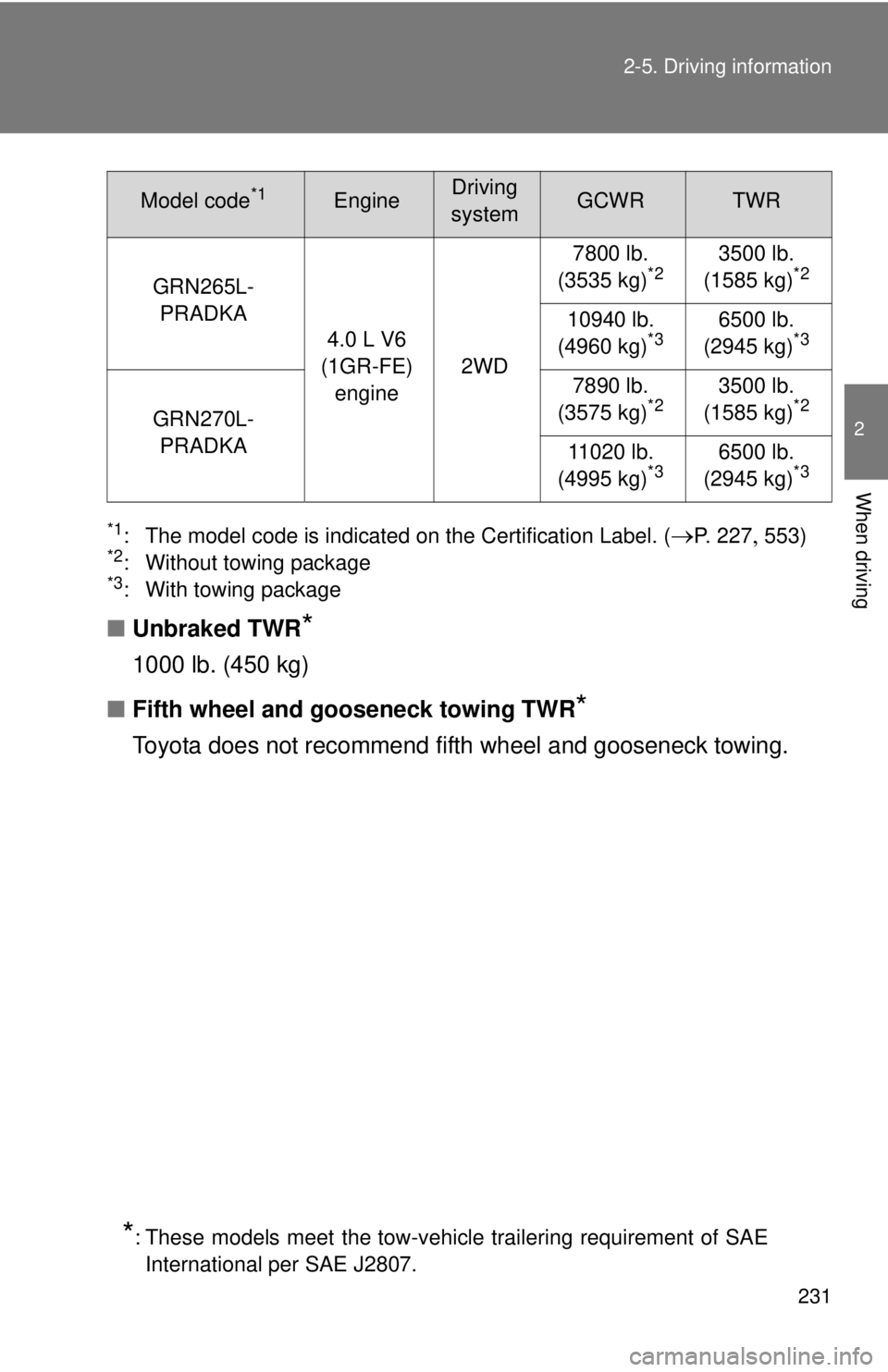
231
2-5. Driving information
2
When driving
*1: The model code is indicated on the Certification Label. (P. 227553)*2: Without towing package*3: With towing package
■
Unbraked TWR*
1000 lb. (450 kg)
■ Fifth wheel and gooseneck towing TWR
*
Toyota does not recommend fifth wheel and gooseneck towing.
GRN265L-
PRADKA 4.0 L V6
(1GR-FE) engine 2WD7800 lb.
(3535 kg)*23500 lb.
(1585 kg)*2
10940 lb.
(4960 kg)*36500 lb.
(2945 kg)*3
GRN270L- PRADKA 7890 lb.
(3575 kg)*23500 lb.
(1585 kg)*2
11020 lb.
(4995 kg)*36500 lb.
(2945 kg)*3
*: These models meet the tow-vehicle trailering requirement of SAE International per SAE J2807.
Model code*1EngineDriving
systemGCWRTWR